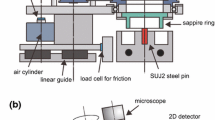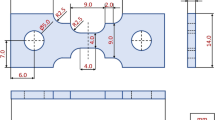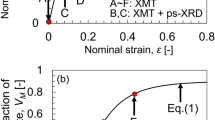Abstract
Martensite is a microconstituent that is indispensable for the strengthening of steels. In recent years, welding residual stresses reduction due to introducing volume expansion of martensitic low temperature transformation (LTT), has received more attention. In the present study, we quantificationally discussed the relationship between the lattice-strain deformation and the martensitic transformation of LTT, by in situ observation technique, using synchrotron X-rays. Martensitic transformation of 14Cr5Ni was observed by hybrid in situ observation technique. Accommodation mechanism of the transformation strain in martensitic transformation process was quantificationally discussed by the diffraction analysis of austenite phase.
Access provided by Autonomous University of Puebla. Download chapter PDF
Similar content being viewed by others
Keywords
1 Introduction
Martensite is a microconstituent that is indispensable for the strengthening of steels. In recent years, welding residual stresses reduction due to introducing volume expansion of martensitic low temperature transformation (LTT), has received more attention. The interplay between a solid state phase transformation and a strain deformation was analyzed in detail through qualitative study with in situ observation [1, 2]. The martensite transformation strain should be relaxed by plastic deformation of the austenite and/or martensite resulting in plastic accommodation (PA). In the present study, we quantificationally discussed the relationship between the lattice-strain deformation and the martensitic transformation of LTT by in situ observation technique using synchrotron X-rays.
2 Experimental
The chemical composition of the sample (14Cr5Ni) are 0.047C, 0.32Si, 0.86Mn, 0.007P, 0.003S, 14.2Cr, 5.2Ni (wt%), and the balance iron. The sample 14Cr5Ni was austenitized by heating to 1,000 °C for 50 s, and then quenching to room temperature. The martensitic transformation of sample 14Cr5Ni during cooling process was observed by using hybrid in situ observation system [2]. In situ synchrotron diffraction experiments were performed in undulator beam line (BL46XU) at the third generation synchrotron radiation source, Spring-8 (Hyogo, Japan). The undulator beam was mono-chromatized by a double Si (111) crystal, and photon energy was 30 keV. The incident beam size was used to 0.5 (H) × 0.5 (W) mm2. The incidence angle was chosen to be 5° between the incident beam and the sample surface. With this setting irradiated area was 2.5 mm2 on the sample surface. The samples were prepared with the dimension of 5 mm in diameter.
The hybrid in situ observation system consists of High-Temperature Laser Scanning Confocal Microscopy (HLSCM) system and Time-Resolved X-ray Diffraction (TRXRD) system [2–4]. In this research, a time resolution was 0.2 s. Diffraction data were acquired with a PILATUS 2M detector [5]. The sample-detector distance was 470 mm, determined with the software Fit2D, using reference powder sample (LaB6).
3 Results and Discussion
Figure 1 shows the in situ observation of morphological development and the diffraction patterns for sample 14Cr5Ni during continuous cooling process. Figure 1a shows the γ-austenite reflections as a spot pattern, because the austenite grain sizes become larger (>100 μm, measured by HLSCM). As shown in Fig. 1b, α-martensitic reflection appeared at 184 °C, which corresponds to the beginning of transformation from γ-austenite to α-martensite. Subsequently, as the transformation proceeded, γ-austenite reflections disappear, as shown in Fig. 1d. This means the transformation from γ-austenite to α-martensite were fully completed.
From careful analysis of the data, the relationship between the temperature and the full width half maximum (FWHM) of {311}γ spot diffraction in both the radial angles(2θ) and the azimuth(φ) were obtained as shown in Fig. 2. That was derived using a fitting function of Gaussian peaks in the {311}γ spot diffraction by integration from 106 to 107.5°, as shown in Fig. 1. It can be found that the FWHM(2θ) was initially 0.02° (see Zone of austenite single phase of Fig. 2a), slowly increased to 0.03° (Zone A of Fig. 2a) and then rapidly increased to 0.13° (Zone B of Fig. 2a). FWHM(φ) was initially 0.07° (see Zone of austenite single phase of Fig. 2b), then slowly increased to 0.09° (Zone A of Fig. 2b) and then rapidly increased to 1.8° (Zone B of Fig. 2b). In the case of coarse austenite grains, diffraction spots correspond to individual grains [6].
Figure 3 shows the lattice constant, obtained by spot diffraction of {311}γ. The temperature dependence of lattice constant (\( a_{\text{TEC}} \)) was calculated by the thermal expansion coefficient (TEC, 24.5 × 10−6/°C) of the sample in the fully austenite phase. As clearly observed in Fig. 3, the change of the actual lattice constant (\( a_{\text{Temp}} \)) did not correspond to \( a_{\text{TEC}} \) in (α + γ) region.
We can suppose that the sample 14Cr5Ni was stress-free state in fully austenite region because the sample was austenitized at 1,000 °C for 50 s. According to the Eq. 1, the lattice-strain of austenitic grain can be calculated.
The lattice-strain of austenite reflection can be calculated for out-of-plane direction. Normal stress of the sample is zero, near the free surface. The in-plane strain can be calculated by out-of-plane strain. For example, when out-of-plane strain is a tension, in-plane strain is calculated to be a compression at Zone A. Figure 4 shows the relationship between temperature and lattice-strain for out-of-plane during continuous cooling process. The lattice-strains were calculated from spot diffractions of austenite (311), (220), (200), respectively. They have the same trends: the lattice-strain increased at the beginning of the transformation (Zone A), then decreased during further cooling (Zone B), as shown in Fig. 4.
In the discussion on FWHM and lattice strain of austenite, we also have to take the effect of transformation strain into account. At the beginning of the transformation (Zone A), all reflections from the austenite increased the FWHM and lattice strain, as shown in Figs. 2 and 4. This indicates that the austenite is deformed plastically to accommodate (PA) the transformation strain. The austenite phase may have compressive stress, at in-plane. On the other hand, we observed that the austenite grain size was fine during martensitic transformation, by using high-temperature laser scanning confocal microscopy (Fig. 1c). Therefore, the FWHM rapidly increased (Zone B in Fig. 2) because the grain size of austenite was small. Meanwhile, lattice strain of austenite decrease, and the compressive stress of austenite change into tensile at out-of-plane, because the small grain size is difficult to accommodate the transformation strain.
4 Conclusions
Martensitic transformation of 14Cr5Ni was observed by hybrid in situ observation technique. Accommodation mechanism of the transformation strain in martensitic transformation process was quantificationally discussed by the diffraction analysis of austenite phase. The main conclusions are as follows:
Initially, the plastic accommodation (PA) mechanism of austenite phase can be dominant in the first stage of martensitic transformation. The austenite phase may have compressive stress at this stage. In the next stage, the compressive stress changes to tensile stress, because the small grain size of austenite may be difficult to accommodate the transformation strain.
References
Zhang S, Morito S, Komizo Y (2012) Variant selection of low carbon high alloy steel in an austenite grain during martensite transformation. ISIJ Int 52(3):510–515
Zhang S, Terasaki H, Komizo Y (2010) In-situ observation of martensite transformation and retained austenite in supermartensitic stainless steel (in Japanese). J Iron Steel Inst Japan (Tetsu-To-Hagane) 96(12):691–697
Terasaki H, Komizo Y (2006) In-situ observation of morphological development for acicular ferrite in weld metal. Sci Technol Weld Join 11(5):561–566
Komizo Y, Terasaki H, Yonemura M, Osuki T (2008) Development of in-situ microstructure observation techniques in welding. Weld World 52(5–6):56–63
Henrich B, Bergamaschi A, Broennimann C, Dinapoli R, Eikenberry EF, Johnson I, Kobas M, Kraft P, Mozzanica A, Schmitt B (2009) PILATUS: a single photon counting pixel detector for X-ray applications. Nucl Instrum Methods Phys Res Sect A-Accel Spectrom Dect Assoc Equip 607(1):247–249. doi:10.1016/j.nima.2009.03.200
Raghunathan SL, Dashwood RJ, Jackson M, Vogel SC, Dye D (2008) The evolution of microtexture and macrotexture during subtransus forging of Ti–10 V–2Fe–3Al. Mater Sci Eng, A 488(1–2):8–15
Acknowledgments
This study was carried out as a part of research activities of Grants-in-Aid for Scientific Research A (No. 23246127) and “Fundamental Studies on Technologies for Steel Materials with Enhanced Strength and Functions” by Consortium of JRCM (The Japan Research and Development Center of Metals). Financial support from NEDO (New Energy and Industrial Technology Development Organization) is gratefully acknowledged. The synchrotron radiation experiments were performed at the BL46XU in the Spring-8 with the approval of the Japan Synchrotron Radiation Research Institute (JASRI) (Proposal No. 2009B2086). The authors are grateful to Dr. T. Shobu for the advice of data analysis.
Author information
Authors and Affiliations
Corresponding author
Editor information
Editors and Affiliations
Rights and permissions
Copyright information
© 2014 Springer International Publishing Switzerland
About this chapter
Cite this chapter
Zhang, S., Komizo, Yi. (2014). In situ Observation of Lattice-Strain and Solid State Transformation in Low Temperature Transformation Weld Metal by Synchrotron X-rays. In: Kannengiesser, T., Babu, S., Komizo, Yi., Ramirez, A. (eds) In-situ Studies with Photons, Neutrons and Electrons Scattering II. Springer, Cham. https://doi.org/10.1007/978-3-319-06145-0_5
Download citation
DOI: https://doi.org/10.1007/978-3-319-06145-0_5
Published:
Publisher Name: Springer, Cham
Print ISBN: 978-3-319-06144-3
Online ISBN: 978-3-319-06145-0
eBook Packages: Chemistry and Materials ScienceChemistry and Material Science (R0)








